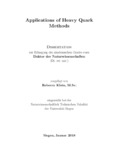Citation link:
https://nbn-resolving.org/urn:nbn:de:hbz:467-12893Files in This Item:
| File | Description | Size | Format | |
|---|---|---|---|---|
| Dissertation_Rebecca_Klein.pdf | 3.52 MB | Adobe PDF |  View/Open |
| Dokument Type: | Doctoral Thesis | metadata.dc.title: | Applications of heavy quark methods Anwendungen der effektiven Theorie schwerer Quarks |
Authors: | Klein, Rebecca | Institute: | Fakultät IV - Naturwissenschaftlich-Technische Fakultät | Free keywords: | Teilchenphysik, Flavourphysik, HQET, Mischung, CP-Verletzung, Particle physics, Flavour physics, HQET, Mixing, CP violation | Dewey Decimal Classification: | 530 Physik | GHBS-Clases: | UHXD UHXO |
Issue Date: | 2018 | Publish Date: | 2018 | Abstract: | For the computation of processes in the Standard Model of Elementary Particle Physics (SM), so-called effective field theories (EFTs) are used. In this way, it is possible to treat corrections systematically. One EFT is the Heavy Quark Effective Theory (HQET), which exploits the fact that in the heavy quark mass limit m_Q --> infinity, a spin as well as a flavor symmetry appears. In this thesis, three applications of HQET are presented. First, the ‘1/2 vs. 3/2’ puzzle is addressed. Here, a tension between the theory prediction and the experimental measurement of semileptonic decays of B mesons into orbitally excited D mesons is observed. For the latter, four different states exist that can be arranged into two spin-symmetry doublets, which are classified by the total angular momentum of their light degrees of freedom j = 1/2 and j = 3/2, respectively. Taking into account the spin of the heavy quark, the states in the j = 1/2 doublet can have a total angular momentum of 0 and 1 and the states in the j = 3/2 doublet 1 and 2. From theory, it is expected that the rates for the decays into the states with j = 3/2 are significantly larger than the ones for j = 1/2. In experiments, however, the measured decay rates are roughly the same. In this thesis, it is investigated if a mixing of the two states with a total angular momentum of 1 can ease this tension. Another aspect of mixing can be observed in the B-anti-B system. Here, the mass difference between the B and anti-B states is determined by the matrix element of the effective local four-quark operator. For the computation of this matrix element a ‘bag parameter’ is introduced which is unity in naive factorization. Any deviation from unity stems from non-factorizable contributions. The bag parameter can be obtained using the established method of sum rules in the context of HQET, which requires the calculation of three-loop diagrams in the case of the non-factorizable contributions. The presented computation completes the next-to-leading order result for the bag parameter. A further application of HQET is QCD factorization, which has recently been extended to three-body decays. In this thesis, CP violation in the decay B --> pi pi pi is studied in that framework. In experimental data, a rich structure of large local CP asymmetries has been observed. It is investigated if this structure can be explained within the QCD factorization approach. Even though some refinement is required, the rough features of the observed CP asymmetry can be reproduced within this model. Zur Berechnung von Prozessen im Standardmodell der Elementarteilchenphysik (SM) werden sogenannte Effektive Feldtheorien (EFT) verwendet. Somit ist es möglich Korrekturen systematisch zu behandeln. Eine EFT ist die Heavy Quark Effective Theory (HQET), welche ausnutzt, dass im Grenzwert der schweren Quarkmasse m_Q --> infinity eine Spin- sowie Flavor-Symmetrie auftritt. In dieser Arbeit werden drei Anwendungen von HQET präsentiert. Zuerst wird das ‘1/2 vs. 3/2’-Puzzle behandelt. Hier wird eine Spannung zwischen den Vorhersagen in der Theorie und den experimentellen Messungen von semileptonischen Zerfällen von B-Mesonen in orbital angeregte D-Mesonen beobachtet. Für letztere existieren vier verschiedene Zustände, die in zwei Spin-Symmetrie-Doublets angeordnet werden können, welche durch den Gesamtdrehimpuls ihrer leichten Freiheitsgrade j = 1/2 und j = 3/2 klassifiziert werden können. Zieht man den Spin des schweren Quarks in Betracht, so können die Zustände im j = 1/2 Doublet einen Gesamtdrehimpuls von 0 und 1 erhalten und die Zustände im j = 3/2 Doublet 1 und 2. Von Seiten der Theorie erwartet man, dass die Zerfallsraten der Zustände mit j = 3/2 signifikant größer sind als die für j = 1/2. Im Experiment werden jedoch Zerfallsraten gemessen die ungefähr gleich groß sind. In dieser Arbeit wird untersucht, ob eine Mischung der beiden Zustände mit einem Gesamtdrehimpuls von 1 diese Spannung auflösen kann. Ein anderer Aspekt von Mischung kann im B-anti-B-System beobachtet werden. Hier wird die Massendifferenz zwischen den B- und anti-B-Zuständen durch das Matrixelement des effektiven lokalen Vier-Quark-Operators bestimmt. Für die Berechnung dieses Matrixelements wird ein ‘Bag-Parameter’ eingeführt der in naiver Faktorisierung Eins ist. Jede Abweichung von Eins rührt von nicht-faktorisierenden Beiträgen her. Der Bag-Parameter kann mit Hilfe der etablierten Methode der Summenregeln im Kontext von HQET bestimmt werden. Im Falle der nicht-faktorisierenden Beiträge erfordert dies die Berechnung von Drei-Schleifen-Diagrammen. Die präsentierte Rechnung komplettiert das Next-to-Leading-Order-Resultat für den Bag-Parameter. Eine weitere Anwendung von HQET ist QCD-Faktorisierung, welche kürzlich auf Dreikörper-Zerfälle erweitert wurde. In dieser Arbeit wird CP-Verletzung im Zerfall B --> pi pi pi in diesem Rahmen untersucht. In experimentellen Daten wird eine komplexe Struktur von großen lokalen CP-Asymmetrien beobachtet. Es wird ermittelt, ob diese Struktur mit der Methode der QCD-Faktorisierung erklärt werden kann. Auch wenn ein paar Verfeinerungen nötig sind, können die groben Merkmale der gemessenen CP Asymmetrie innerhalb des Models reproduziert werden. |
URN: | urn:nbn:de:hbz:467-12893 | URI: | https://dspace.ub.uni-siegen.de/handle/ubsi/1289 | License: | https://dspace.ub.uni-siegen.de/static/license.txt |
| Appears in Collections: | Hochschulschriften |
This item is protected by original copyright |
Page view(s)
619
checked on Nov 29, 2024
Download(s)
233
checked on Nov 29, 2024
Google ScholarTM
Check
Items in DSpace are protected by copyright, with all rights reserved, unless otherwise indicated.

